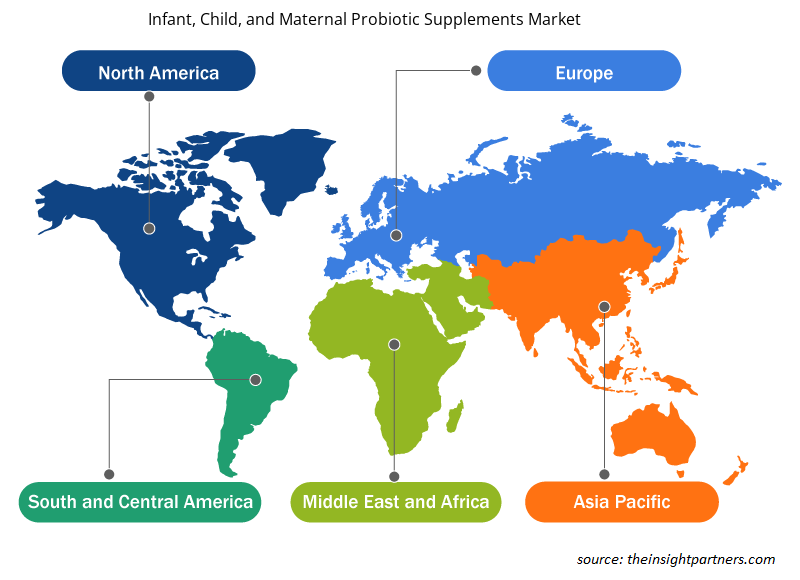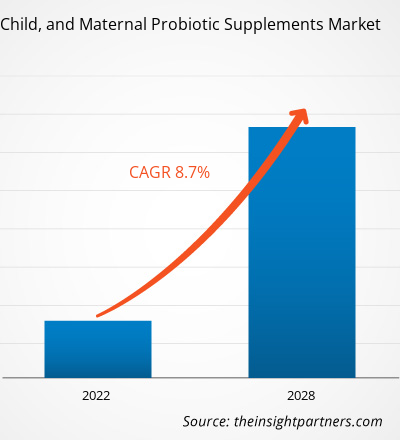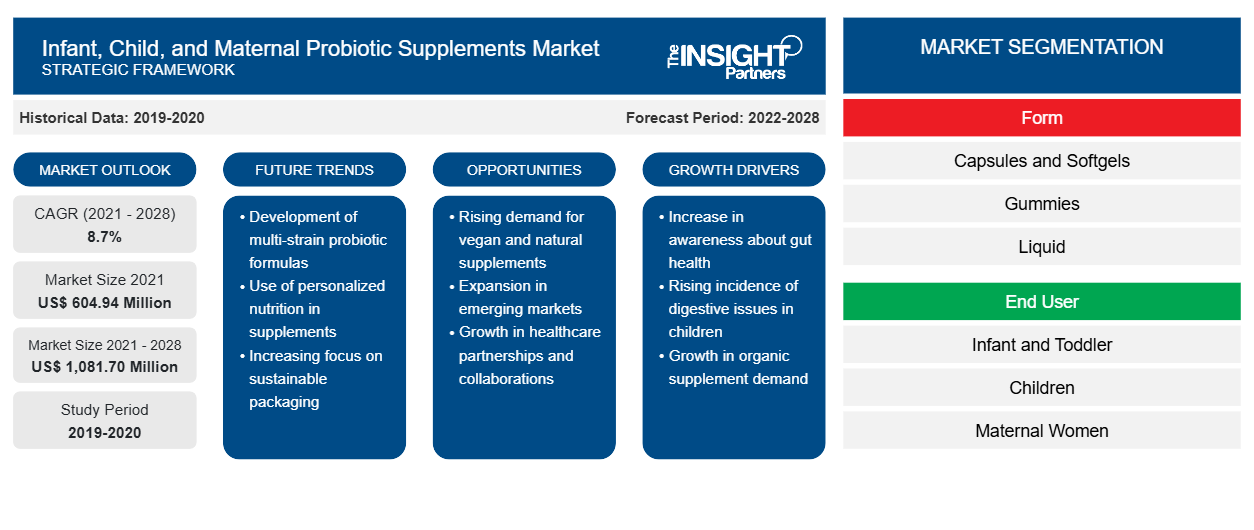Si prevede che il mercato degli integratori probiotici per neonati, bambini e madri raggiungerà 1.081,70 milioni di dollari entro il 2028, rispetto ai 604,94 milioni di dollari del 2021. Si prevede che crescerà a un CAGR dell'8,7% dal 2022 al 2028.probiotic supplements market is projected to reach US$ 1,081.70 million by 2028 from US$ 604.94 million in 2021. It is expected to grow at a CAGR of 8.7% from 2022 to 2028.
I probiotici sono batteri vivi e/o lieviti, che giovano alla salute intestinale della persona. Vari benefici degli are live bacteria and/or yeast, which benefit the person's gut health. Various benefits of integratori probiotici supplements includono il potenziamento del microbioma intestinale, il ripristino dell'equilibrio del microbioma e il supporto del sistema immunitario. Tali benefici hanno aumentato il suo utilizzo tra il pubblico di riferimento, che include neonati, bambini e donne incinte. I genitori si stanno concentrando sempre di più sulla nutrizione e il benessere dei loro figli, guidando il mercato. Inoltre, la crescente adozione di integratori probiotici tra le donne incinte ha aumentato notevolmente il mercato. La costante R&S che si svolge in questa categoria in tutto il mondo aumenterà la crescita del mercato nei prossimi annimicrobiome, restoring balance to the microbiome, and supporting the immune system. Such benefits have surged its use among the target audience, which includes infants, children, and maternal women. Parents are increasingly focusing on their child’s nutrition and well-being, driving the market. Also, the increasing adoption of probiotic supplements among pregnant women has boosted the market substantially. Constant R&D taking place in this category across the globe will uplift the market growth in the coming years
Nel 2020, il Nord America ha detenuto la quota maggiore del mercato globale degli integratori probiotici per neonati, bambini e madri e si stima che l'Asia Pacifica registrerà il CAGR più rapido durante il periodo di previsione. L'aumento della popolazione, lo sviluppo economico e l'aumento del reddito disponibile sono alcuni fattori che contribuiscono alla crescita del mercato. La popolazione delle economie emergenti, come India, Cina e Giappone, sta adottando integratori alimentari per migliorare la crescita e lo sviluppo dei bambini. Inoltre, l'aumento del tasso di mortalità infantile nelle economie emergenti ha alimentato la domanda di integratori probiotici nella regione. Ad esempio, secondo la Banca Mondiale, nel 2020, il tasso di mortalità infantile nell'Asia orientale e nel Pacifico era di 11 ogni 1.000 nati vivi.
Personalizza questo report in base alle tue esigenze
Riceverai la personalizzazione gratuita di qualsiasi report, comprese parti di questo report, o analisi a livello nazionale, pacchetto dati Excel, oltre a usufruire di grandi offerte e sconti per start-up e università
- Scopri le principali tendenze di mercato in questo rapporto.Questo campione GRATUITO includerà analisi di dati che spaziano dalle tendenze di mercato alle stime e alle previsioni.
Impatto della pandemia di COVID-19 sul mercato degli integratori probiotici per neonati, bambini e madri
Prima dell'inizio della pandemia di COVID-19, il mercato degli integratori probiotici per neonati, bambini e madri era guidato principalmente dalla crescente attenzione dei genitori per l'alimentazione specifica dei neonati e dalla crescente domanda di integratori nutrizionali su misura in base alle esigenze delle donne incinte. Tuttavia, il mercato ha dovuto affrontare sfide senza precedenti dopo lo scoppio dell'epidemia nel 2020. I produttori di integratori probiotici per neonati, bambini e madri hanno dovuto affrontare sfide significative a causa dei vincoli della catena di fornitura causati da lockdown a livello nazionale, divieti commerciali e restrizioni di viaggio. Le interruzioni della catena di fornitura hanno creato una carenza di materie prime, che ha influenzato la produzione e la distribuzione di vari prodotti, portando a un aumento dei prezzi.probiotic supplements market was mainly driven by the rising focus of parents on specific infant nutrition and the increasing demand for nutritional supplements tailored according to the needs of pregnant women. However, the market faced unprecedented challenges after the outbreak in 2020. Manufacturers of infant, child, and maternal probiotic supplements faced significant challenges due to supply chain constraints caused by nationwide lockdowns, trade bans, and travel restrictions. Supply chain disruptions created a shortage of raw materials, which affected the production and distribution of various products, leading to increased prices.
Nel 2021, varie economie hanno ripreso le operazioni poiché i governi hanno annunciato un allentamento delle restrizioni precedentemente imposte, il che ha dato una spinta al mercato globale. Inoltre, è stato consentito agli impianti di produzione di funzionare a piena capacità, il che li ha aiutati a superare il divario tra domanda e offerta e altre ripercussioni. Poiché numerosi cittadini di molti paesi erano completamente vaccinati entro il 2021, gli operatori di mercato si sono concentrati sull'aumento della produzione per rilanciare le loro attività.
Approfondimenti di mercato
La crescente consapevolezza dei benefici degli integratori probiotici tra le donne incinte per guidare il mercato degli integratori probiotici per neonati, bambini e madriProbiotic Supplements among Pregnant Women to Drive Infant, Child, and Maternal Probiotic Supplements Market
I probiotici riducono il rischio di preeclampsia nelle donne incinte, una condizione di salute che provoca ipertensione e alti livelli di proteine nelle urine. Gli integratori probiotici assicurano anche una migliore immunità per le donne incinte, il che aiuta a combattere le malattie croniche e a garantire la buona salute del bambino. Lactobacillus acidophilus, Bifidobacterium bifidum e Saccharomyces boulardii sono tra i ceppi probiotici più efficaci e ampiamente utilizzati negli integratori probiotici prenatali. Questi ceppi aiutano a mantenere una flora intestinale sana e riducono il rischio di varie allergie, malattie e complicazioni, tra cui diabete gestazionale e preeclampsia. La crescente consapevolezza dei benefici degli integratori probiotici tra le donne incinte sta guidando sostanzialmente il mercato degli integratori probiotici per neonati, bambini e madri. lower the risk of pre-eclampsia in pregnant women, a health condition resulting in high blood pressure and high protein levels in urine. Probiotic supplements also ensure better immunity for pregnant women, which helps fight chronic diseases and ensure the baby's good health. Lactobacillus acidophilus, Bifidobacterium bifidum, and Saccharomyces boulardii are among the most effective and widely used probiotic strains in prenatal probiotic supplements. These strains help to maintain a healthy intestinal flora and reduce the risk of various allergies, diseases, and complications, including gestational diabetes and pre-eclampsia. The growing awareness about the benefits of probiotic supplements among pregnant women is substantially driving the infant, child, and maternal probiotic supplements market.
Informazioni sul modulo
In base alla forma, il mercato degli integratori probiotici per neonati, bambini e madri è suddiviso in capsule e softgel, caramelle gommose, liquidi e altri. Il segmento degli altri ha detenuto la quota maggiore del mercato durante il periodo di previsione. Tuttavia, si prevede che il segmento delle caramelle gommose registrerà il CAGR più elevato durante il periodo di previsione. Le caramelle gommose probiotiche dolci e facili da consumare sono disponibili in colori e forme accattivanti (come gli orsacchiotti di peluche) e vari gusti. Diversi produttori sono impegnati in innovazioni di prodotto per soddisfare le crescenti richieste di adulti e bambini. Tali sviluppi strategici da parte dei produttori per diversificare la loro gamma di prodotti probabilmente spingeranno la domanda di caramelle gommose per neonati, bambini e madri negli anni a venire.
Informazioni per l'utente finale
In base all'utente finale, il mercato degli integratori probiotici per neonati, bambini e madri è suddiviso in neonati e bambini piccoli, bambini e donne madri. Il segmento dei bambini ha rappresentato la quota di mercato maggiore nel 2020. Gli integratori probiotici stanno guadagnando popolarità in questi bambini poiché svolgono un ruolo fondamentale nell'alleviare coliche, stitichezza acuta e reflusso acido. Alcuni ricercatori hanno dimostrato che i probiotici possono aiutare a prevenire la diarrea correlata agli antibiotici nei bambini, quindi i pediatri spesso includono gli integratori probiotici quando prescrivono antibiotici.probiotic supplements market is segmented into infants and toddlers, children, and maternal women. The children segment accounted for the largest market share in 2020. Probiotic supplements are gaining popularity in these children as they play a vital role in relieving colic, acute constipation, and acid reflux. Some researchers have shown that probiotics can help prevent antibiotic-related diarrhea in children, so pediatricians often include probiotic supplements while prescribing antibiotics.
I principali attori che operano nel mercato degli integratori probiotici per neonati, bambini e madri includono Bayer Corporation; Nestle SA; Mommy's Bliss Inc.; LoveBug Probiotics; BioGaia AB; MaryRuth Organics, LLC; Pharmavite LLC; Evolve Biosystems; Biomeology; e Nordic Naturals. Queste aziende stanno puntando sul lancio di nuovi prodotti e sulle espansioni geografiche per soddisfare la crescente domanda dei consumatori in tutto il mondo. Hanno una presenza globale diffusa, che consente loro di servire un ampio gruppo di clienti da tutto il mondo e di conseguenza aumenta la loro quota di mercato. Questi attori di mercato si concentrano molto sul lancio di nuovi prodotti e sulle espansioni regionali per aumentare la loro gamma di prodotti nei portafogli specializzati.probiotic supplements market include Bayer Corporation; Nestle S.A.; Mommy’s Bliss Inc.; LoveBug Probiotics; BioGaia AB; MaryRuth Organics, LLC; Pharmavite LLC; Evolve Biosystems; Biomeology; and Nordic Naturals. These companies are emphasizing on new product launches and geographical expansions to meet the growing consumer demand worldwide. They have a widespread global presence, which provides them to serve a large set of customers from all over the world and subsequently increases their market share. These market players focus heavily on new product launches and regional expansions to increase their product range in specialty portfolios.
Approfondimenti regionali sul mercato degli integratori probiotici per neonati, bambini e madri
Le tendenze e i fattori regionali che influenzano il mercato degli integratori probiotici per neonati, bambini e madri durante il periodo di previsione sono stati ampiamente spiegati dagli analisti di Insight Partners. Questa sezione discute anche i segmenti di mercato degli integratori probiotici per neonati, bambini e madri e la loro geografia in Nord America, Europa, Asia Pacifico, Medio Oriente e Africa e Sud e Centro America.

- Ottieni i dati specifici regionali per il mercato degli integratori probiotici per neonati, bambini e madri
Ambito del rapporto di mercato sugli integratori probiotici per neonati, bambini e madri
| Attributo del report | Dettagli |
|---|---|
| Dimensioni del mercato nel 2021 | 604,94 milioni di dollari USA |
| Dimensioni del mercato entro il 2028 | 1.081,70 milioni di dollari USA |
| CAGR globale (2021 - 2028) | 8,7% |
| Dati storici | 2019-2020 |
| Periodo di previsione | 2022-2028 |
| Segmenti coperti | Per modulo
|
| Regioni e Paesi coperti | America del Nord
|
| Leader di mercato e profili aziendali chiave |
|
Integratori probiotici per neonati, bambini e madri: densità dei player del mercato: comprendere il suo impatto sulle dinamiche aziendali
Il mercato degli integratori probiotici per neonati, bambini e madri sta crescendo rapidamente, spinto dalla crescente domanda degli utenti finali dovuta a fattori quali l'evoluzione delle preferenze dei consumatori, i progressi tecnologici e una maggiore consapevolezza dei benefici del prodotto. Con l'aumento della domanda, le aziende stanno ampliando la propria offerta, innovando per soddisfare le esigenze dei consumatori e capitalizzando sulle tendenze emergenti, il che alimenta ulteriormente la crescita del mercato.
La densità degli operatori di mercato si riferisce alla distribuzione di aziende o società che operano in un particolare mercato o settore. Indica quanti concorrenti (operatori di mercato) sono presenti in un dato spazio di mercato in relazione alle sue dimensioni o al valore di mercato totale.
Le principali aziende che operano nel mercato degli integratori probiotici per neonati, bambini e madri sono:
- Società Bayer
- Nestlé SA
- Mamma
Disclaimer : le aziende elencate sopra non sono classificate secondo un ordine particolare.

- Ottieni una panoramica dei principali attori del mercato degli integratori probiotici per neonati, bambini e madri
Segnala i riflettori
- Tendenze industriali progressive nel mercato degli integratori probiotici per neonati, bambini e madri per aiutare le aziende a sviluppare strategie efficaci a lungo termine
- Strategie di crescita aziendale adottate dagli operatori del mercato degli integratori probiotici per neonati, bambini e madri nei paesi sviluppati e in via di sviluppo
- Analisi quantitativa del mercato dal 2020 al 2028
- Stima della domanda globale di indumenti da lavoro
- Analisi delle cinque forze di Porter per illustrare l'efficacia di acquirenti e fornitori nel mercato degli integratori probiotici per neonati, bambini e madri
- Sviluppi recenti per comprendere lo scenario competitivo del mercato
- Tendenze e prospettive di mercato, nonché fattori che guidano e frenano la crescita del mercato degli integratori probiotici per neonati, bambini e madri
- Assistenza nel processo decisionale evidenziando le strategie di mercato che sostengono l'interesse commerciale
- Dimensioni del mercato degli integratori probiotici per neonati, bambini e madri in vari nodi
- Una panoramica dettagliata e le dinamiche del settore degli abiti da lavoro
- Dimensioni del mercato degli integratori probiotici per neonati, bambini e madri in varie regioni con promettenti opportunità di crescita
- Analisi storica (2 anni), anno base, previsione (7 anni) con CAGR
- Analisi PEST e SWOT
- Valore/volume delle dimensioni del mercato - Globale, Regionale, Nazionale
- Industria e panorama competitivo
- Set di dati Excel
Report recenti
Rapporti correlati
Testimonianze
Motivo dell'acquisto
- Processo decisionale informato
- Comprensione delle dinamiche di mercato
- Analisi competitiva
- Analisi dei clienti
- Previsioni di mercato
- Mitigazione del rischio
- Pianificazione strategica
- Giustificazione degli investimenti
- Identificazione dei mercati emergenti
- Miglioramento delle strategie di marketing
- Aumento dell'efficienza operativa
- Allineamento alle tendenze normative





















 Ottieni un campione gratuito per - Mercato degli integratori probiotici per neonati, bambini e madri
Ottieni un campione gratuito per - Mercato degli integratori probiotici per neonati, bambini e madri